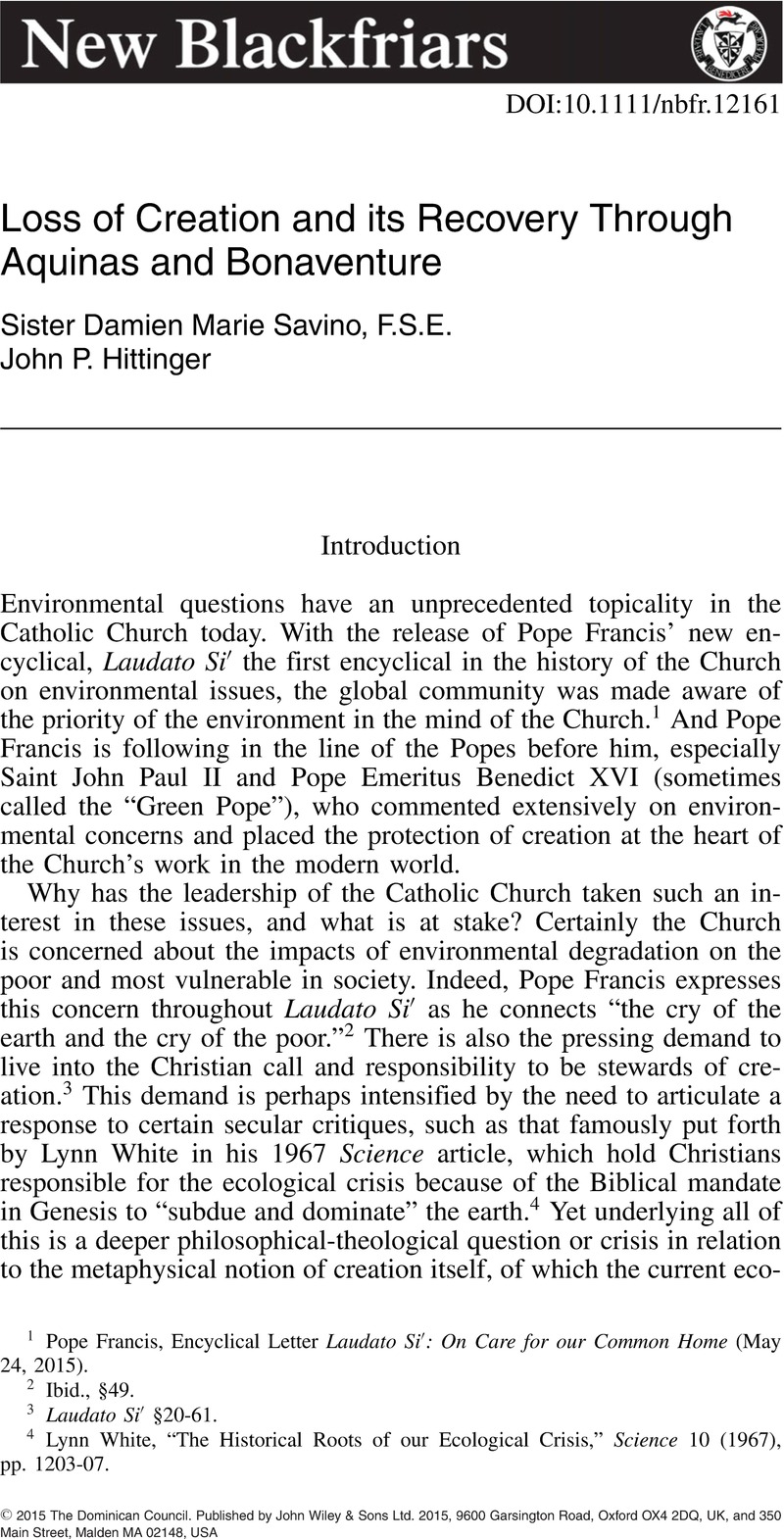No CrossRef data available.
Article contents
Loss of Creation and its Recovery Through Aquinas and Bonaventure
Published online by Cambridge University Press: 01 January 2024
Abstract

Information
- Type
- Original Article
- Information
- Copyright
- Copyright © 2015 The Dominican Council. Published by John Wiley & Sons Ltd.
References
1 Pope Francis, Encyclical Letter Laudato Si′: On Care for our Common Home (May 24, 2015).
2 Ibid., §49.
3 Laudato Si′ §20-61.
4 White, Lynn, “The Historical Roots of our Ecological Crisis,” Science 10 (1967), pp. 120-307Google Scholar.
5 Laudato Si′ §101-136, 2, 9, 15, 144.
6 Ratzinger, Joseph Cardinal, ‘In the Beginning’: A Catholic Understanding of the Story of Creation and the Fall (Grand Rapids: Eerdmans, 1995), pp. 92-95Google Scholar.
7 Ibid., pp. 96-99. See alsoVoegelin, Eric, Science, Politics, and Gnosticism (South Bend: Gateway, 1968), pp. 13-50.Google Scholar
8 Kant, Immanuel, Critique of Pure Reason, Smith, Norman Kemp, trans. (New York: Macmillan Press, 1990), pp. xiiiGoogle Scholar.
9 Bacon, Francis, The New Organon and Related Writings, Anderson, Fulton H., ed. (Indianapolis: Bobbs-Merrill, 1960), pp. 8, 15, 95, 273Google Scholar.
10 Descartes, Discourse on Method, Part 6, in Philosophical Works (Cambridge: Haldane and Ross, 1972) Vol. 1, pp. 119-20Google Scholar. See also Kennington, , “Descartes and Mastery of Nature,” On Modern Origins: Essays in Early Modern Philosophy (Lanham: Lexington Books, 2004), pp. 123-44Google Scholar.
11 Lewis, C.S., Abolition of Man (New York: MacMillan, 1965)Google Scholar.
12 Guardini, Romano, The World and the Person (Chicago: H. Regnery Co, 1965), p. 11Google Scholar.
13 William E. Carroll, “Aquinas and the Big Bang,” First Things (November 1999), p. 19.
14 Carroll, William E., “Creation, Evolution, and Thomas Aquinas,” Revue des Questions Scientifiques 171:4 (2000): pp. 319-47Google Scholar.
15 Paul, John II, God: Father and Creator, Vol. 1 (Boston, MA: Daughters of St. Paul, 1996), p. 218Google Scholar.
16 Ibid., p. 217.
17 Guardini, The World and the Person, p. 11.
18 Ratzinger, ‘In the Beginning,’ p. 37.
19 Ibid., p. 38.
20 John Paul II, God: Father and Creator, p. 219.
21 Ratzinger, ‘In the Beginning,’ p. 79.
22 Baldner, Steven E. and Carroll, William E., trans., Aquinas on Creation (Toronto, Canada: Pontifical Institute of Mediaeval Studies, 1997), p. 32Google Scholar.
23 Ibid., p. 66. Garrigou-Lagrange, Reginald, The Trinity and God the Creator (Ex Fontibus Co., 2012), pp. 368-69Google Scholar.
24 Gilby, Thomas, ed., Aquinas, Thomas, Summa Theologiae: Volume 8, Creation, Variety and Evil (Cambridge: Cambridge University Press, 2009), pp. 148–49Google Scholar.
25 Baldner and Carroll, Aquinas on Creation, p. 74.
26 Ibid., p. 76. See also pp. 44-45.
27 Carroll, “Aquinas and the Big Bang,” p. 19.
28 Aquinas, I Sent., d.1,q.8, a.4.1 and II Sent., d.1,q.1,a.2. See also: ST I, q.45, a.3; and Pope, Stephen J., “Neither Enemy Nor Friend: Nature as Creation in the Theology of Saint Thomas Aquinas,” Zygon 32: 2 (1997), pp. 222-23CrossRefGoogle Scholar.
29 John Paul II, Letter to Artists (1999), §1.
30 Pieper, Josef, Guide to Thomas Aquinas (San Francisco: Ignatius Press, 1991), pp. 133-46Google Scholar.
31 Baldner and Carroll, Aquinas on Creation, 74.
32 Ibid., pp. 74-75.
33 Ibid., pp. 76-77.
34 Pieper, Joseph, Leisure, the Basis of Culture (South Bend: St. Augustine's Press, 1998)Google Scholar.
35 Pieper, Joseph, The Silence of St. Thomas (New York: Pantheon Books, 1957), p. 48Google Scholar.
36 Chesterton, G. K., St. Thomas Aquinas and St Francis of Assisi (San Francisco, CA: Ignatius Press, 2002), p. 232Google Scholar.
37 Christopher Cullen, “The Semiotic Metaphysics of St. Bonaventure,” PhD diss. (The Catholic University of America, 2000), p. 104. Cullen, Also, Bonaventure, (Oxford: Oxford University Press), p. 71Google Scholar.
38 LaNave, Gregory F., “God, Creation, and the Possibility of Philosophical Wisdom: The Perspectives of Bonaventure and Aquinas,” Theological Studies 69 (2008), pp. 828-30CrossRefGoogle Scholar.
39 Ibid., p. 830.
40 Bonaventure, I Sent., d.2, q.2, note 2.
41 Bonaventure, II Sent., d.1, pt. 1, ch. 3.
42 Bonaventure, II Sent., d.1, pt.1, a.3, q.2, concl.
43 Bonaventure, I Sent. d.31, pt.2, dubium 6, tome1.
44 Bowman, Leonard J., “The Cosmic Exemplarism of Bonaventure,” The Journal of Religion 55: 2 (1975), pp. 182-83CrossRefGoogle Scholar.
45 Cullen, “Semiotic Metaphysics of Bonaventure,” p. 153. Cf. I Sent. d.35, a.1, q.1, ad 3.
46 Bonaventure, II Sent., d.12, a.1, q.2, concl.
47 Ibid.
48 Gilson, Etienne, The Philosophy of Bonaventure (Paterson, NJ: St. Anthony Guild Press, 1965), p. 200Google Scholar.
49 Ibid., pp. 191-93. Cf. I Sent., d.3, a.1, q.1,2, fund.4, t.I, and I Sent., d.3, a.1, un. ad 4, t.1.
50 Sister Savino, Damien Marie, “Atheistic Science: The Only Option?” Logos: A Journal of Catholic Thought and Culture, Vol 12:4 (2009), pp. 56-73CrossRefGoogle Scholar.
51 Bonaventure, , “Prologue to the First Book of Sentences,” in Bonaventure: Mystic of God's Word, Johnson, Timothy. ed., (New York: New City Press, 1999), p. 51Google Scholar.
52 Bowman, “Cosmic Exemplarism,” pp. 197-98.
53 LaNave, “God, Creation, and Philosophical Wisdom,” p. 828.
54 Benedict XVI, Caritas in Veritate, §48.
55 Bonaventure, “Prologue to the Third Book of Sentences,” in Bonaventure: Mystic of God's Word, p. 65.
56 Bonaventure, “Prologue to the Second Book of Sentences,” in Bonaventure: Mystic of God's Word, p. 59.
57 Ibid., p. 61.
58 Sister Miller, Paula Jean, Marriage: The Sacrament of Divine-Human Communion (Quincy, IL: Franciscan Press, 1996), p. 46Google Scholar.
59 Bonaventure, II Sent., d.12, a.1, q.2, concl. 4.5.6.
60 Bonaventure, “Prologue to the Second Book of Sentences,” p. 61.
61 Ibid., p. 62.
62 Bonaventure, “Prologue to the First Book of Sentences,” in Bonaventure: Mystic of God's Word, p. 50.
63 Ibid., p. 59.
64 Bonaventure, “Prologue to the Second Book of Sentences,” pp. 63-64.
65 C.S. Lewis, Abolition of Man, p. 89.
66 Bonaventure, Journey of the Soul to God, Ch. 1:No. 15, Vol 2 in Boehner, Philotheus & Hayes, Zachary OFM, eds., Works of Bonaventure (St. Bonaventure, NY: Franciscan Institute, 2002)Google Scholar.

